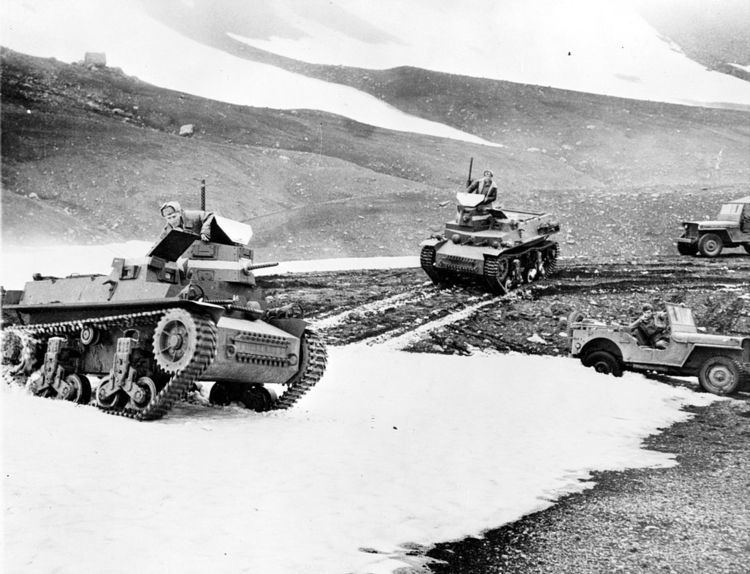Type Light tank/tankette Manufacturer Marmon-Herrington | Place of origin United States No. built 875 | |
 | ||
Used by Netherlands
United States
Indonesia
Republic of China Wars World War II
Indonesian National Revolution | ||
The Marmon-Herrington Combat Tank Light Series were a series of U.S. light tanks/tankettes that were produced for the export market at the start of the Second World War. The CTL-3 had a crew of two and was armed with two .30 cal (7.62 mm) M1919 machine guns and one .50 cal (12.7 mm) M2 Browning machine gun. They were originally designed to be amphibious light tanks. They were rejected by the Marines in 1939, but after the attack on Pearl Harbor they were exported and used as an emergency light tank.
Contents
It primarily served in Alaska and the Dutch East Indies, while small numbers were used in the U.S. as guard tanks stationed along the U.S. coast. A total of about 700 examples were produced, and although it was declared obsolete by the Allies in 1943, it was used by the newly created Indonesian Army after the end of the Second World War, remaining in Indonesian service until 1949.
Design and development
In the mid-1930s, the U.S. Marines required a light tank that could be used in amphibious operations. After trials with Christie amphibious tanks, Marmon Herrington produced a light, turretless tank with a 0.5 in (13 mm) M2 machine gun and two .30 cal (7.62 mm) M1919 machine guns. This was the first light tank to meet USMC standards when it was designed. With a crew of two, consisting of the driver and gunner, and protected by up to 0.5 in (12.7 mm) of armor, it was named the Combat Tank Light 3 (CTL-3). All three machine guns were mounted on ball mounts on the front hull.
Fitted with bogie leaf suspension, the tank was 6 ft 10 in (2.08 m) wide, 11 ft 6 in (3.51 m) long, with a height of 6 ft 11 in (2.11 m). It weighed 4.7 short tons (4,300 kg), and was powered by a Lincoln V-12, Hercules 6-cylinder gasoline engine, providing 120 hp (89 kW). It was capable of speeds of up to 33 mph (53 km/h), and had a range of 125 mi (201 km). Five prototypes were produced in 1936 to be tested. Five more were produced in 1939. Tests continued until 1940, after which the Marine Corps deemed it obsolete because of the goals to make it amphibious which left it with fragile tracks and weak armor. The Marine Corps thus relegated it to training use only.
American use
A small number were used by the US Marine Corps' 1st Tank and 1st Scout Companies prior to the war. Some were employed on Western Samoa. None of those tanks saw action. After the attack on Pearl Harbor, the Ordnance Committee determined that a few CTLS-4TAC and 4TAYs would be dispersed to the U.S. Army and employed in the Aleutian Islands campaign. Under Ordnance Committee Minutes (OCM) 18526, these examples were subsequently designated as the Light Tank T16 and Light Tank T14 respectively.
Foreign use
A total of 628 CTMS tanks were ordered by the Royal Netherlands East Indies Army. Of these, a small number were delivered to Java, just in time to see combat in the Dutch East Indies campaign following the Japanese invasion in early 1942. 149 from this order were diverted to Australia where they were used for training. 600 CTLS-4TACs and 4TAYs were delivered to China under Lend-Lease after Pearl Harbor. After the war, the Indonesian Army is reported to have used several captured Dutch vehicles, with the type remaining in Indonesian service until 1949 amidst the Indonesian National Revolution.
Variants
Branching projects
Two other tank designs were produced by Marmon-Herrington that branched directly from the CTLS. They were both intended to be shipped to the Dutch, but were overtaken by the Ordnance Department.
CTMS-1TB1
The CTMS-1TB1 project was started in 1941 to produce a three-man light tank for the Dutch Army. It was armed with a 37 mm (1.5 in) automatic cannon and coaxial M1919 machine gun. They originally meant to send 600 of them to the Dutch East Indies campaign to aid the Dutch. However, the campaign ended too early for prototypes to be sent. The project was then taken over by the Ordnance Department and was tested at Aberdeen Proving Grounds in early 1943. Other, more robust light tanks were being produced at the time, and there was no need for stop-gap solutions so the prototypes were rejected for U.S. use in May 1943.
MTLS-1G14
The MTLS-1G14 project was started at the same time as the CTMS-1TB1 to produce a four-man medium tank for the Dutch Army. It was armed with two 1.5 in (37 mm) automatic cannons. It also was equipped with five M1919 machine guns, three of which were mounted on the hull, one mounted coaxially, and one mounted on the top of the turret. The armor was bolted and measured between 0.5–1.5 in (13–38 mm). The design was soon taken over by the Ordnance Department and was tested at Aberdeen in April 1943. It was rejected by the U.S Army because there were better medium tanks already in production.
